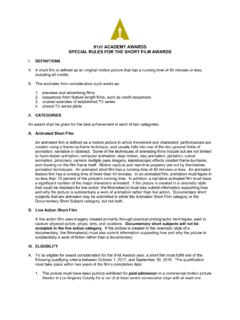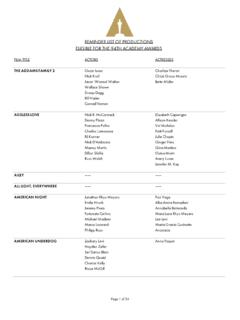Transcription of COSTUME DESIGN - Oscars
1 2014 AMPAS | COSTUME DESIGN INSTRUCTIONAL GUIDE | PAGE 1 COSTUME DESIGNDEFINING CHARACTERPIRATES OF THE CARIBBEAN: CURSE OF THE BLACK PEARL (2003) COSTUME Designer Penny RosePROGRAM COMPONENTS1. This instructional guide2. Four student activity reproducible masters3. COSTUME DESIGN Glossary and Suggested Resources4. Supplemental DVD optional5. Selected Films for Student ViewingTARGET AUDIENCEThis program has been designed for students in secondary school arts, literature, science and communications OBJECTIVES1. To enhance student interest in and knowledge about the motion picture creative development and the film production process2. To encourage students to use critical thinking3. To engage students in an exploration of film as an art form and a medium of communication and expression4. To help students improve their media literacy5. To heighten visual and observational skillsCOSTUME DESIGNDEFINING CHARACTERINSTRUCTIONAL GUIDEThis teacher s guide was created in collaboration with Deborah Nadoolman Landis, , founding director, The David C.
2 Copley Center for the Study of COSTUME DESIGN , UCLA. 2014 AMPAS | COSTUME DESIGN INSTRUCTIONAL GUIDE | PAGE 1hether a film is set in the present, the past, in a distant location or in an imaginary time and place, COSTUME designers collaborate with the director, the cinematographer and the production designer to tell the story. COSTUME designers collaborate with actors to bring the characters in the screenplay to tell a story using cinematic language that consists of narrative (the screenplay) and visual (the film frame) elements. Film is a director s medium. The audience sees exactly what the director wants us to see. The director chooses what to reveal or conceal about a character and a dramatic situation. After filming is completed, the director will work with an editor to create the film out of all the scenes that were filmed during (2009) COSTUME Designers Deborah L.
3 Scott & Mayes Rubeo 2014 AMPAS | COSTUME DESIGN INSTRUCTIONAL GUIDE | PAGE 2 Costumes: Telling the Story and Creating the CharacterEvery garment worn in a movie is considered a COSTUME . Costumes are one of many tools the director has to tell the story. Costumes communicate the details of a character s personality to the audience, and help actors transform into new and believable people on is often confusion between COSTUME DESIGN and fashion DESIGN ; however, these two fields and their objectives are very different. Fashion designers have labels and sell their clothes, while COSTUME designers have no labels and are focused on creating authentic characters in a story. COSTUME designers create both beautiful gowns for a glamorous entrance and everyday clothes when required by the script.
4 They must know who characters are before they create a closet of clothes and accessories for the characters. A COSTUME is worn by one actor, as one specific character, in a specific scene or scenes in the story. Most important, the audience must believe that every person in a story has a life before the movie begins. The COSTUME DESIGN process begins with studying the screenplay. Scripts describe the action (what happens in the scene), the time period (when the action takes place), the location (where the action takes place), and the characters in each scene. After reading the script, the COSTUME designer meets with the director to discuss the overall vision for the film. Two different directors will make different movies from the same script. At the first meeting with the director, the COSTUME designer may learn about the casting choices and specifics about characterization, the overall color palette and the mood of the speaking with the director, the COSTUME designer begins the research portion of the DESIGN process.
5 This may include research on the Internet and at archives, museums and libraries; reviewing periodicals, school yearbooks and family albums; and studying historical and contemporary visual references. Research may also include field trips to such locations as offices, hospitals and police stations, depending on the setting of the example, if a scene takes place in a modern-day high school, a COSTUME designer will visit a local high school. High schools in different parts of the country have dramatically different cultures, socioeconomic influences and diverse populations who dress differently. The screenplay will dictate the specific location of the story and the designer will be careful to be very specific in his or her research. The designer will compile an album, called a research bible, containing portraits of staff, teachers and students.
6 More research will be done into the taste and style of the students, including their shopping habits. It may be a surprise that modern films are often more difficult to COSTUME than historical films. It is distracting for the audience when the costumes are unrealistic for a scene, too expensive for a character or wrong for a dramatic situation. The designer s goal is for the costumes to blend into the story seamlessly and for the audience to be completely engaged in the (2002) COSTUME Designer Julie Weiss 2014 AMPAS | COSTUME DEISGN INSTRUCTIONAL GUIDE | PAGE 3 Harry Potter and the Sorcerer s Stone (2001), mixes modern, period and fantasy costuming. COSTUME designer Judianna Makovsky researched modern yet traditional English private school uniforms. Makovsky depended upon her imagination to create the costumes for Hogwarts colorful faculty and staff.
7 Although Harry Potter and his friends Ron and Hermione exist in an imaginary world, they are modern teenagers, and when required must be dressed appropriately in jeans and T-shirts. When a screenplay covers several decades, or is set in a distant location, costumes help the audience know when and where each scene takes place. The 2002 film Frida is based on the life of Mexican artist Frida Kahlo (Salma Hayek). COSTUME designer Julie Weiss dressed Hayek first in a schoolgirl uniform, then as a young matron in the stylish dresses of the 1920s, then in colorful hand-embroidered Mexican-Indian blouses. The real Frida Kahlo wore traditional Mexican clothes as she became more confident as an artist and political activist. Kahlo s changing costumes reflect her personal often adapt vintage clothing, as Ruth E.
8 Carter did for Lee Daniels The Butler (2013), the story of an African-American butler (played by Forest Whitaker) who served eight presidents over a span of more than 30 years. Carter mixed the vintage garments she found with ones that she designed using vintage printed fabrics. The audience is taken on a journey through time, from 50s pleats to 70s hair to 80s polyester tracksuits. Carter insisted on the right fabric for each garment, creating the authentic style and shape that she found in her research. Costumes do not have to duplicate the film s period exactly, but they do need to look right to the audience. Designers may exaggerate color, style and silhouette for dramatic effect. For Marie Antoinette (2006), director Sofia Coppola felt that a pastel color palette inspired by French macarons would be more appealing to a young female audience, so designer Milena Canonero created sherbet-colored dresses.
9 These gowns had the right silhouette for the period, but their colors did not resemble those of garments from the court of Marie Antoinette that are preserved in modern museums. Show your students a period film (one set in the distant or recent past). Discuss how the costumes reveal when and where the film takes place. Do the period costumes affect the actor s movement? Ask students to research actual clothing from that period using COSTUME and history books, as well as historical portrait paintings. Compare actual historical costumes to the costumes in the film. How much do the people in the film look like the portraits in the paintings? How do they differ? What elements of the COSTUME might be in fashion today? What elements of the COSTUME might not be in style today?SUPPLEMENTAL ACTIVITY Have each of your students describe an article of clothing or an accessory that he or she is wearing.
10 Ask each to relate how he or she obtained the item. Was it a gift or a purchase? How long has he or she had it? Does it have sentimental value? Discuss with your students how this kind of analysis and research is useful for designing POTTER AND THE SORCERER S STONE (2001) COSTUME Designer Judianna Makovsky 2014 AMPAS | COSTUME DESIGN INSTRUCTIONAL GUIDE | PAGE 4 Costumes: Creating PeopleI n real life, clothes define our taste and are an expression of our personality. It s rare that people wear new clothes each day. On a typical day, a teenager might wear a favorite well-worn skirt, a pair of earrings from the local mall, her mom s sweater and a birthday scarf from her best friend. When a movie begins, we meet the characters for the first time, and like us, each character is dressed in clothes that reflect their unique personality and shooting starts, the director, COSTUME designer and actor consider the character s personality, challenges (such as anxiety, depression, money troubles or a drinking problem), and dramatic arc (the emotional and psychological changes the character undergoes through the film).















